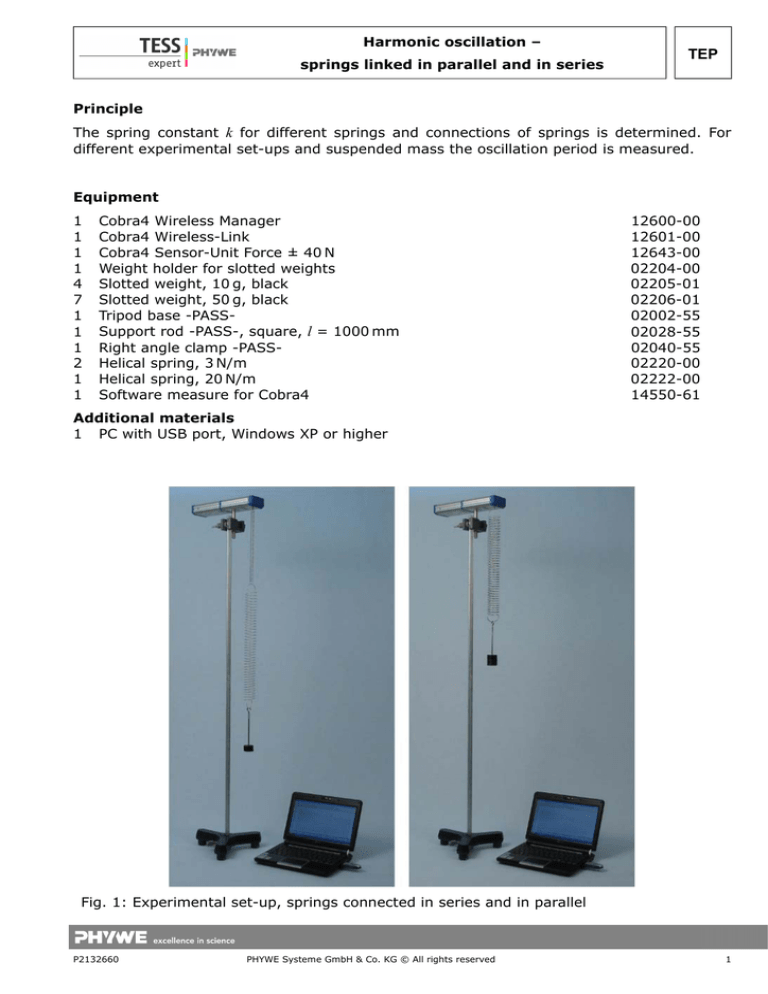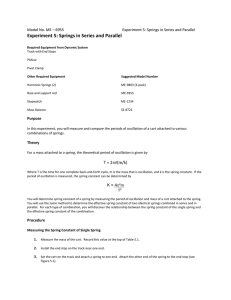Harmonic Oscillation: Springs in Series & Parallel Experiment
advertisement

Harmonic oscillation – springs linked in parallel and in series TEP Principle The spring constant k for different springs and connections of springs is determined. For different experimental set-ups and suspended mass the oscillation period is measured. Equipment 1 1 1 1 4 7 1 1 1 2 1 1 Cobra4 Wireless Manager Cobra4 Wireless-Link Cobra4 Sensor-Unit Force ± 40 N Weight holder for slotted weights Slotted weight, 10 g, black Slotted weight, 50 g, black Tripod base -PASSSupport rod -PASS-, square, l = 1000 mm Right angle clamp -PASSHelical spring, 3 N/m Helical spring, 20 N/m Software measure for Cobra4 12600-00 12601-00 12643-00 02204-00 02205-01 02206-01 02002-55 02028-55 02040-55 02220-00 02222-00 14550-61 Additional materials 1 PC with USB port, Windows XP or higher Fig. 1: Experimental set-up, springs connected in series and in parallel P2132660 PHYWE Systeme GmbH & Co. KG © All rights reserved 1 TEP Harmonic oscillation – springs linked in parallel and in series Set-up • In accordance with Fig. 1 the spring constants of the springs are measured. In total three springs are used: spring 1 and spring 2 with a spring constant of k = 3 N/m and spring 3 with k = 20 N/m. • Three measurement series are to be performed. At first, set each of the springs (spring 1 or spring 2 and spring 3) oscillating with varying suspended masses, determine the oscillation period and calculate the spring constant. Then connect two springs in parallel and in series and determine the spring constant again. • The combinations of springs and suspended mass that are to be measured are listed in tables 1–3. Procedure • Start the PC and Windows. • Plug the Cobra4 Wireless Manager in the USB port of the PC. • Start the measure software package on the PC. • Switch on the Cobra4 Wireless-Link with attached Cobra4 Sensor-Unit Force 40 N. The sensor is now automatically recognized and is allotted an ID-number (01) that is shown in the Cobra4 Wireless-Link display. Communication between the Cobra4 Wireless Manager and the Cobra4 Wireless-Link is shown by the Data LED. • On being switched on, the force sensor is tared, i.e. at the start it shows a weight of 0 N. • Load experiment (Experiment > Open experiment). All necessary settings for the recording of measured values will now be started. • Start measured value recording in measure • Record the oscillation of the spring pendulum for approx. 1 minute, then end the . Choose “send all data to measure”. Repeat the measurement for all measurement combinations of springs and suspended mass. . Results and Evaluation • A typical measurement result is shown in Fig. 2. The spring force is at a minimum at the upper inversion point (no extension by the weight) and at a maximum at the lower inversion point (maximum expansion by the weight). The oscillation period T can be determined from the recorded measurement either from the distance apart of the oscillation maxima, or by means of Fourier analysis. Both methods will be described in the following. • To determine the oscillation period T from the distance between oscillation maxima of force, use the “Survey” function ( ) as follows. Position the cursor lines so that they lie on the oscillation maxima for the distance that is to be measured. The individual measurement points can be shown with “Display options”, “Symbols”. It is recommended that you determine the distance between several measurement points (a total of ten here) and then take the average for better accuracy. 2 PHYWE Systeme GmbH & Co. KG © All rights reserved P2132660 Harmonic oscillation – springs linked in parallel and in series TEP The survey gives for k = 20 N/m, m = 250 g (Fig. 2): T 10 = 7.21 s • ⇒ T = 0.721 s ⇒ f = 1.39 Hz The oscillation period of the spring can be alternatively obtained using the “Fourier analysis” function ( ) (Fig. 3). The additional use of the “Peak analysis” function ( ) enables it to be clearly seen that the frequency of the characteristic oscillation lies at 1.39 Hz. The oscillation period is again found to be 0.717 s. Fig. 2: Typical measurement result, use of survey function Fig. 3: Use of Fourier analysis and peak analysis function to determine the oscillation frequency P2132660 PHYWE Systeme GmbH & Co. KG © All rights reserved 3 Harmonic oscillation – TEP • springs linked in parallel and in series According to Hooke's law, which describes the connection between the restoring force F and the displacement X with a spring constant k, the following is valid for an ideal spring under slight displacement: F = −k ⋅ X . Solving the equation of motion, the following is obtained for the oscillation period of a spring pendulum of mass m: T = 2π √ m k and from this ( ) k = m⋅ • 2π 2 T Table 1 and table 2 confirm this relationship. For different masses the spring constant has a constant value within the scope of the measuring accuracy. The weaker spring is loaded with the smaller masses to avoid overstretching. Nevertheless, it can be seen that the value of the spring constant k slightly increases with increasing mass. The reason is that Hooke's law is only applicable for small deflections, otherwise the linear correlation becomes invalid. In an extreme case the spring can be even completely overstretched so that it does not return to its original form subsequent to unloading. The deviation also results because the mass and inner friction of the spring are not taken into account in the mathematical expressions. Table 1: Spring 1 m/g T/s k / N/m 60 0.917 2.8 80 1.038 2.9 100 1.149 3.0 150 1.406 3.0 m/g T/s k / N/m 250 0.721 19.0 300 0.789 19.0 350 0.848 19.2 400 0.903 19.4 Table 2: Spring 3 4 PHYWE Systeme GmbH & Co. KG © All rights reserved P2132660 Harmonic oscillation – TEP springs linked in parallel and in series • If springs, even of the same kind, are linked in parallel or in series, the total spring constant changes in a characteristic manner. When two springs are linked in parallel, each spring will be displaced by the same stretch and accordingly exert a restoring force on the weight. The individual forces add together (Fig. 4) Assuming this, we obtain arithmetically: F = F 1 + F 2 = −( k 1+ k 2 )⋅ X • ⇒ k = k 1+ k2 In the serial linkage, the individual displacements of the springs add together to a total displacement, so that the displacing force and the restoring force are identical for the two springs (Fig. 5). The following is valid: F = −k 1⋅ X 1 ⇔ ( X = X 1+ X 2 = − X1 = − 1 1 ) F k1 + ⋅F k1 k 2 and ⇔ F = − k2⋅ X 2 ⇔ X2 = − 1 ⇒ 1 F =− 1 1 + k1 k 2 ⋅X k = 1 F k2 1 + k1 k 2 Table 3 shows exemplary measurements, which fulfil the relationships given above. Table 3: Connected springs Spring, coupling m/g T/s kmeasured / N/m Spring 1 60 0.917 2.8 — Spring 2 60 0.883 3.0 — Spring 3 350 0.903 19.2 — Springs 1, 2 series 60 1.330 1.3 1.5 Springs 1, 3 series 60 1.010 2.3 2.5 Springs 1, 2 parallel 110 0.860 5.9 5.9 Springs 1, 3 parallel 310 0.743 22.2 22.0 P2132660 PHYWE Systeme GmbH & Co. KG © All rights reserved kcalculated / N/m 5 TEP Harmonic oscillation – springs linked in parallel and in series Fig. 4: Parallel connection of helical springs 6 Fig. 5: Series connection of helical springs PHYWE Systeme GmbH & Co. KG © All rights reserved P2132660



